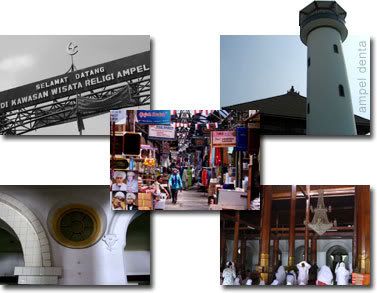A brief history of Ampel Denta

Raden Muhammad Ali Rahmatullah
Also known as Sunan Ampel, a descendant of the holy messenger Muhammad SAW, was born in Champa (southern part of Cambodia, CMIIW). Raden Muhammad Ali Rahmatullah arrived at Java in the early of 15th century. His mission was to fix the moral of Majapahit kingdom's noble and peasant, which has been a total riot after Prabu Hayam Wuruk and Mahapatih Gajah Mada have departed.
Raden Muhammad Ali Rahmatullah practices the Hanafian mahzab rules (fiqih). However, to his pupils, he only teaches one simple principle: 'Moh limo' (five no's).
1. Moh main (no gambling)
2. Moh minum (no drinking)
3. Moh maling (no stealing, no corrupting)
4. Moh madat (no drugs)
5. Moh madon (no free sex)
The background of Sunan Ampel's pupils varied from Majapahit officials, Majapahit citizens, and even people from remote areas. Even in 1470s, came a Persian (Iran), young man named Ali Saksar to study to Sunan Ampel. Later, he was known as Syeikh Siti Jenar.
The Great Mosque of Sunan Ampel
Built in 1421 and located in Ampel district, Pabean Cantikan, in the northern part of Surabaya (7°13'45.42" S, 112°44'30.84" E).
 With ancient javanese architectural style, it uses three leveled roof, unlike the one in middle east and eastern europe, it doesn't have any dome. Supported by 16 pillars of teak wood, 17m in length and 60cm in diameter. The amazing thing about these wooden pillars is that they stand 'without any brace', causing unsolved mystery up until today: How to transport those gigantic logs to Ampel when all transportation and construction means were still unsophisticated at that time?
With ancient javanese architectural style, it uses three leveled roof, unlike the one in middle east and eastern europe, it doesn't have any dome. Supported by 16 pillars of teak wood, 17m in length and 60cm in diameter. The amazing thing about these wooden pillars is that they stand 'without any brace', causing unsolved mystery up until today: How to transport those gigantic logs to Ampel when all transportation and construction means were still unsophisticated at that time?In the west side of the mosque there is a graveyard where Sunan Ampel and his best friends are buried, along with the hajj syuhadas. Nearby the graveyard entry there are several large earthenware bowl contains drinking water from a well under the mosque that never dry up.
In Ampel quarter, there are 5 gates surrounding the site of The Great Mosque of Sunan Ampel (as the symbol of 5 Pillars of Islam):
1. Gapura Peneksen (Syahadat, a testimony that there's no god but Allah SWT)
2. Gapura Madep (Sholat, to worship god facing the kiblat)
3. Gapura Ngamal (Zakat, to do zakat/shodaqoh when afford to)
4. Gapura Poso (Puasa, to fast such as in the ramadhan month)
5. Gapura Munggah (Haji, to do hajj when afford to)
Mbah Bolong and the kiblat
 Shonhaji was one of Sunan Ampel's pupils. At the time of the mosque's construction, Shonhaji was the one who points the kiblat direction. The direction was then used as reference to the mosque building.
Shonhaji was one of Sunan Ampel's pupils. At the time of the mosque's construction, Shonhaji was the one who points the kiblat direction. The direction was then used as reference to the mosque building.When the mosque was completely built, Sunan Ampel's pupils were still having doubt on the mosque's direction. Is it accurately facing the kiblat? Shonhaji then made a hole at mosque's wall, just at the right of imam's position in the mosque. And he said "Look through this hole, the holy ka'bah should be visible to you". Thus Sunan Ampel's pupils look through the hole, and they see the holy ka'bah with their very own eyes. Since then, Shonhaji known as Mbah Bolong.
Mbah Sholeh and the nine graves
Mbah Sholeh was a janitor at The Great Mosque of Sunan Ampel during the life of Sunan Ampel. He worked very dilligent, very clean. So no people would ever felt dust when praying anywhere inside the great mosque.
When Mbah Sholeh passed away, he was buried at the eastern part of the mosque complex. Thus the mosque became dirty. And Sunan Ampel uttered "If only Mbah Sholeh was still alive, this mosque should have been clean". Suddenly there was Mbah Sholeh sweeping the floor at the imam's position. Few months later, Mbah Sholeh passed away (again), and buried (again) next to his previous grave. The case was then reoccured, and Sunan Ampel's utterance was again spoken. Thus Mbah Sholeh came back to life.
After eight deaths of Mbah Sholeh, Sunan Ampel passed away. And few months later, Mbah Sholeh passed away too. And never came back to life. So there are nine graves of Mbah Sholeh in the complex of The Great Mosque of Sunan Ampel.
Our responsibilities as the next generation
So how do we honor Sunan Ampel, and the other wise men of wali songo?
As the next generation, we must protect what has been developed, and continue their works. We also pray to Allah SWT, wish them a lot of rewards (pahala) for their works and a place in heaven.
Pictures of Ampel
More pictures of Ampel are available in my multiply album:

Bonus: Culinary exotics of Ampel Denta
 Ampel Denta is known as Arab district of Surabaya city. Arab cuisine and restaurants are easy to find in this area. One of them is Al-Mutlik Restaurant, at the Kyai Haji Mas Mansyur street. Not only serves Arab cuisine, Al-Mutlik also has javanese food on the menu list. But of course, the Arab style of various kinds of food from lamb of this restaurant holds the best reputation for its fine quality.
Ampel Denta is known as Arab district of Surabaya city. Arab cuisine and restaurants are easy to find in this area. One of them is Al-Mutlik Restaurant, at the Kyai Haji Mas Mansyur street. Not only serves Arab cuisine, Al-Mutlik also has javanese food on the menu list. But of course, the Arab style of various kinds of food from lamb of this restaurant holds the best reputation for its fine quality.The reputation of Al-Mutlik is widely known. Food at Al-Mutlik has been labeled 'Mak Nyus' by Mr. Bondan Winarno (Wisata Kuliner, TransTV). And also labeled 'Ajiiib...' by Fauzi Baadila (Nikmatnya Dunia, SCTV).
Al-Mutlik kebuli rice, is served with big portion of fried lamb ribs. The rice tastes rich, tough it might be a bit too spicy for caucasian appetite. One serving of kebuli rice is quite generous, but surprisingly inexpensive. It costs eight thousand rupiah only. Considering the quality of the cuisine, I personally think it is still fair if such delicacy is valued sixteen thousand rupiah. Another menu for you sould try: maryam bread. It costs three thousand rupiah only.
So if you ever have a chance to visit Ampel, feel free to explore Nyamplungan or Kyai Haji Mas Mansyur streets. You will find so many Arab culinary spots there :)
Links:
- Para Pencari Tuhan
- Spiritualisme Abadi Masjid Ampel
- Masjid Tiban, Makam Aulia Sunan Kuning
- Cheng Hoo
Credits:
- Zam and Galihsatria for the inspiration
- Bapak juru kunci for the info
- Atas and Tyka for the lingo
Wednesday, December 12, 2007 11:37:00 AM
asiikk pertamaaaahhh...!!
aduhh kok pake bhs inggris sih?? susah taukk... aku bingung mo komen apa :( kau cuman copy paste dari wikipedia yaa??
mi... laper mi...
Wednesday, December 12, 2007 12:51:00 PM
Weleh, jadi kengen surabaya nih mas
Wednesday, December 12, 2007 6:11:00 PM
blm pernah ke ampel :(
Wednesday, December 12, 2007 10:34:00 PM
nek aku nang suroboyo, elingno nang ampel denta yo utowo rawon bengi iku, opo jenenge...lali aku :D
Thursday, December 13, 2007 5:42:00 AM
This comment has been removed by a blog administrator.
Thursday, December 13, 2007 5:50:00 AM
Liputan masjid rahmatnya dipublish pisan mas, kan sekalian, masih satu seri, masih satu sejarah dg masjid ampel ini.
-L-
Thursday, December 13, 2007 6:11:00 AM
rasanya aku pernah lewat ke sekitar mesjid ini. tapi gak sempet mampir..
asik juga spt nya ya..?
Thursday, December 13, 2007 6:29:00 AM
lho kok komenku di busek? tak bunuh koen yooo abis itu tak mutilasi!!!!
kembalikan komenku!!!!
lho kok jadi pake moderasi :))
=))
Thursday, December 13, 2007 6:30:00 AM
awas nek gak di approve!!
Thursday, December 13, 2007 7:49:00 AM
Waw.. great post! akhirnya muncul juga postingan ngampel-nya hehe... sekalian aja dimasukin ke wikipedia :)
Thursday, December 13, 2007 9:17:00 AM
Di Al-Mutlik Restaurant ada kambing oven ga mas ?
Eh.. aneh, kok aku bisa ketinggalan banyak posting disini ya :( Kayaknya Google Readerku error :(
Thursday, December 13, 2007 10:05:00 AM
ngliat gambar yg trakhir...gambar makanan seporsi itu...aku jadi LAPER!
*kabur ke dapur*
Thursday, December 13, 2007 5:20:00 PM
laporannya dahsyat...bonus laporan Culinary lage. Soal Mbah Bolong..bahasa Inggrisnya "Grandpa Hole ???" upsstt
Thursday, December 13, 2007 6:29:00 PM
kata temenku suasana mesjidnya kayak di mekah ya...
*btw knapa skrg musim moderasi komen sih.. :p
Thursday, December 13, 2007 7:08:00 PM
1. "The amazing thing about these wooden pillars is that they stand 'without any brace'" <-- ini maksudnya apa, mi?
2. apakah melalui bolongan itu orang masih melihat Ka'bah? atau bolongan itu susah diakses tanpa tangga?
3. bau dengar legenda Mbah Sholeh dan kuburannya itu, kemaren aku lihat gak ya?
4.
Thursday, December 13, 2007 9:23:00 PM
duuhh aku pengen banget wisata2 ketempat2 itu... pernah dulu kesana,,tapi masih kecil udah lupa.
yg aku inget cuma dulu disana banyak bgt pengemis2 disepanjang jalan..apa sekarang masih kayak gitu???
Friday, December 14, 2007 4:49:00 PM
boso enggres...
ah, aku rindu ampel yg dulu..
Friday, December 14, 2007 10:54:00 PM
Rey: laper rey? mari kemari :) mari lengkapi wawasan bebek gorengmu di surabaya, mari :)
venus: make sure lebaran depan kesini lagi yah ;) nanti foto2an di house of sampoerna! :D
Hedi: rawon setan hed. dan sekarang udah buka 24 jam kok, nggak perlu begadang lagi ;)
-L-: bantu nulis napa? boleh titip publish di blog sini kok. free of casss.
DenaDena: security, arrest this lunatic!
A New Day Has Come: masih kurang bobot ah untuk wiki entry, mau nambah material?
http://www.inijie.com: kambing oven ada, tapi nggak tak foto. details japri aja via imel yah.
Si Jagoan Makan: Holey Grand daddy!!
faniez: bangunan mesjidnya justru pake arsitektur jawa kuno. tapi kampung ampelnya memang kayak kampung seng.
mina: 1. jadi kayu2 jati raksasa itu wujudnya satu potong utuh. kalo material kayu jaman sekarang kan dipotong2 kecil2 supaya gampang diolah, kemudian disusun lagi dg konsep pengikatan/konstruksi modern. kalo yg itu enggak, asli potongan dari pohon gitu deh. kamu perlu kesini lagi, masuk masjid, dan liat sendiri kayu itu.
mina: 2. aku belom pernah dapet informasi bahwa ada orang jaman sekarang yg bisa liat ka'bah dari bolongan itu.
mina: 3. liat kok, tapi nggak konsen, soalnya banyak ketutupan orang jual merchandise :D
mina: 4.
ichaAwe: kalo pas jumatan ato 'ada acara' di masjid ampel, pengemis2 itu bermunculan entah dari mana.
Friday, December 14, 2007 11:50:00 PM
cempluk dah pernah sekali loh mampir ke masjid ampel..
Saturday, December 15, 2007 10:00:00 AM
Keren..belum pernah kesono..terinspirasi..
Tuesday, June 16, 2009 10:11:00 AM
yg versi bhasa indo da g ya?